
Linear A is a writing system that was used by the Minoans of Crete from 1800 BC to 1450 BC. Linear A was the primary script used in palace and religious writings of the Minoan civilization. It was succeeded by Linear B, which was used by the Mycenaeans to write an early form of Greek. It was discovered by the archaeologist Sir Arthur Evans in 1900. No texts in Linear A have yet been deciphered. Evans named the script "Linear" because its characters consisted simply of lines inscribed in clay, in contrast to the more pictographic characters in Cretan hieroglyphs that were used during the same period.

Linear B is a syllabic script that was used for writing in Mycenaean Greek, the earliest attested form of the Greek language. The script predates the Greek alphabet by several centuries, the earliest known examples dating to around 1400 BC. It is adapted from the earlier Linear A, an undeciphered script potentially used for writing the Minoan language, as is the later Cypriot syllabary, which also recorded Greek. Linear B, found mainly in the palace archives at Knossos, Kydonia, Pylos, Thebes and Mycenae, disappeared with the fall of Mycenaean civilization during the Late Bronze Age collapse. The succeeding period, known as the Greek Dark Ages, provides no evidence of the use of writing.
The Phoenician alphabet is a consonantal alphabet used across the Mediterranean civilization of Phoenicia for most of the 1st millennium BCE. It was the first mature alphabet, and attested in Canaanite and Aramaic inscriptions found across the Mediterranean region. In the history of writing systems, the Phoenician script also marked the first to have a fixed writing direction—while previous systems were multi-directional, Phoenician was written horizontally, from right to left. It developed directly from the Proto-Sinaitic script used during the Late Bronze Age, which was derived in turn from Egyptian hieroglyphs.
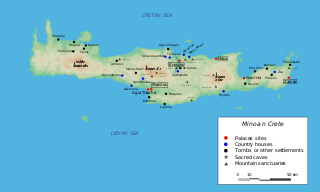
The Minoan civilization was a Bronze Age culture which was centered on the island of Crete. Known for its monumental architecture and energetic art, it is often regarded as the first civilization in Europe. The ruins of the Minoan palaces at Knossos and Phaistos are popular tourist attractions.

In Greek mythology, Idomeneus was a Cretan king and commander who led the Cretan armies to the Trojan War, in eighty black ships. He was also one of the suitors of Helen, as well as a comrade of the Telamonian Ajax. Meriones was his charioteer and brother-in-arms.
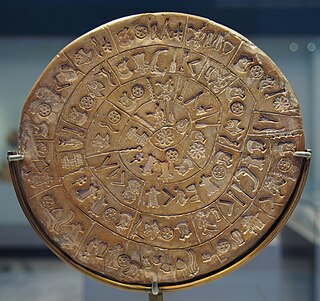
The Phaistos Disc or Phaistos Disk is a disk of fired clay from the island of Crete, Greece, possibly from the middle or late Minoan Bronze Age, bearing a text in an unknown script and language. Its purpose and its original place of manufacture remain disputed. It is now on display at the archaeological museum of Heraklion. The name is sometimes spelled Phaestos or Festos.
Ugarit was an ancient port city in northern Syria about 10 kilometers north of modern Latakia. At its height it ruled an area roughly equivalent to the modern Latakia Governorate. It was discovered by accident in 1928 with the Ugaritic texts. Its ruins are often called Ras Shamra after the headland where they lie.

Luwian, sometimes known as Luvian or Luish, is an ancient language, or group of languages, within the Anatolian branch of the Indo-European language family. The ethnonym Luwian comes from Luwiya – the name of the region in which the Luwians lived. Luwiya is attested, for example, in the Hittite laws.

Zakros is a Minoan archaeological site on the eastern coast of Crete. It is regarded as one of the five Minoan palaces, and its protected harbor and strategic location made it an important commercial hub for trade to the east.

The Cypriot or Cypriote syllabary is a syllabic script used in Iron Age Cyprus, from about the 11th to the 4th centuries BCE, when it was replaced by the Greek alphabet. It has been suggested that the script remained in use as late as the 1st century BC. A pioneer of that change was King Evagoras of Salamis. It is thought to be descended from the Cypro-Minoan syllabary, in turn, a variant or derivative of Linear A. Most texts using the script are in the Arcadocypriot dialect of Greek, but also one bilingual inscription was found in Amathus.

Minoan pottery has been used as a tool for dating the mute Minoan civilization. Its restless sequence of quirky maturing artistic styles reveals something of Minoan patrons' pleasure in novelty while they assist archaeologists in assigning relative dates to the strata of their sites. Pots that contained oils and ointments, exported from 18th century BC Crete, have been found at sites through the Aegean islands and mainland Greece, in Cyprus, along coastal Syria and in Egypt, showing the wide trading contacts of the Minoans.

The Arkalochori Axe is a 2nd millennium BC Minoan bronze votive double axe (labrys) excavated by Spyridon Marinatos in 1934 in the Arkalochori cave in Crete, which is believed to have been used for religious rituals. It is inscribed with fifteen symbols.
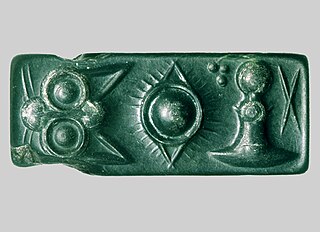
Cretan hieroglyphs are a hieroglyphic writing system used in early Bronze Age Crete, during the Minoan era. They predate Linear A by about a century, but the two writing systems continued to be used in parallel for most of their history. As of 2024, they are undeciphered.

The Byblos script, also known as the Byblos syllabary, Pseudo-hieroglyphic script, Proto-Byblian, Proto-Byblic, or Byblic, is an undeciphered writing system, known from ten inscriptions found in Byblos, a coastal city in Lebanon. The inscriptions are engraved on bronze plates and spatulas, and carved in stone. They were excavated by Maurice Dunand, from 1928 to 1932, and published in 1945 in his monograph Byblia Grammata. The inscriptions are conventionally dated to the second millennium BC, probably between the 18th and 15th centuries BC.
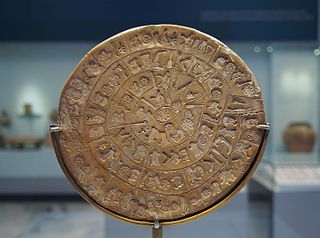
Many people have claimed to have deciphered the Phaistos Disc.
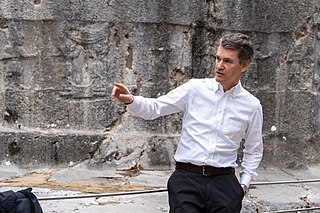
Eberhard Zangger is a Swiss geoarchaeologist, corporate communications consultant and publicist. Since 1994 he has been advocating the view that a Luwian civilization existed in Western Asia Minor during the 2nd millennium BC. In 2014 he established the international non-profit foundation Luwian Studies, whose president he is.
The Cypro-Minoan syllabary (CM), more commonly called the Cypro-Minoan Script, is an undeciphered syllabary used on the island of Cyprus and at its trading partners during the late Bronze Age and early Iron Age. The term "Cypro-Minoan" was coined by Arthur Evans in 1909 based on its visual similarity to Linear A on Minoan Crete, from which CM is thought to be derived. Approximately 250 objects—such as clay balls, cylinders, and tablets which bear Cypro-Minoan inscriptions, have been found. Discoveries have been made at various sites around Cyprus, as well as in the ancient city of Ugarit on the Syrian coast. It is thought to be somehow related to the later Cypriot syllabary.
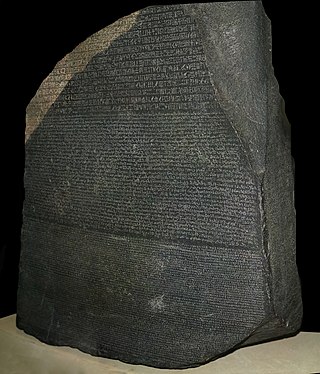
In epigraphy, a multilingual inscription is an inscription that includes the same text in two or more languages. A bilingual is an inscription that includes the same text in two languages. Multilingual inscriptions are important for the decipherment of ancient writing systems, and for the study of ancient languages with small or repetitive corpora.

Frederik Christiaan Woudhuizen was a Dutch independent scholar who studied ancient Indo-European languages, hieroglyphic Luvian/Luwian, and Mediterranean protohistory. He was the former editor of Talanta, Proceedings of the Dutch Archaeological and Historical Society.
Luwian Studies is an independent, private, non-profit foundation based in Zürich, Switzerland. Its sole purpose is to promote the study of cultures of the second millennium BC in western Asia Minor. The foundation encourages and supports archaeological, linguistic and natural scientific investigations to complete the understanding of Middle and Late Bronze Age Mediterranean cultures. Western Anatolia was, at that point in time, home to groups of people who spoke Luwian, an Indo-European language.

![Clay label of king Muwa from Mallia (sector Mu). A = front, B = back. Image from Het Byblosschrift ontcijferd - In het voetspoor van Willem Glasbergen [nl] ClayLableOfKingMuwaFromMallia-SectorMu-Afront-Bback.jpg](http://upload.wikimedia.org/wikipedia/commons/thumb/3/38/ClayLableOfKingMuwaFromMallia-SectorMu-Afront-Bback.jpg/220px-ClayLableOfKingMuwaFromMallia-SectorMu-Afront-Bback.jpg)















